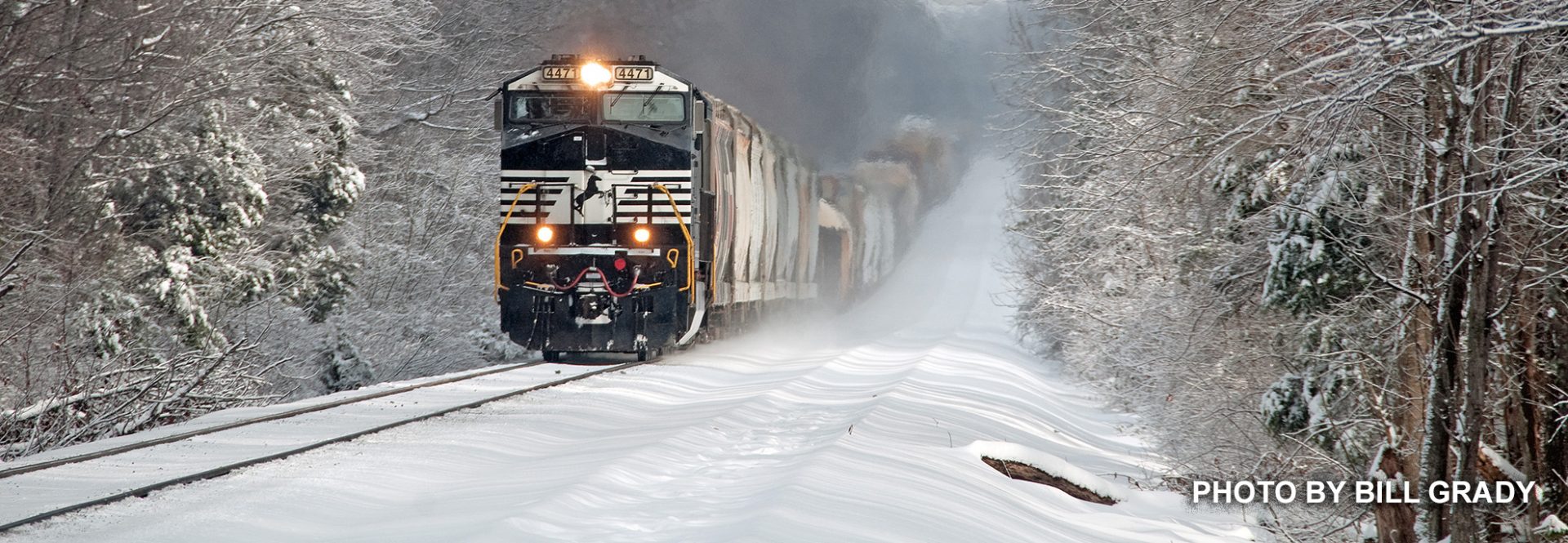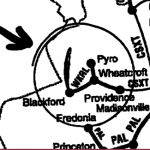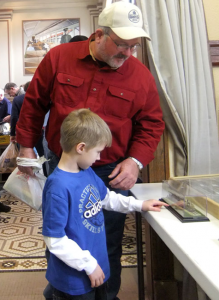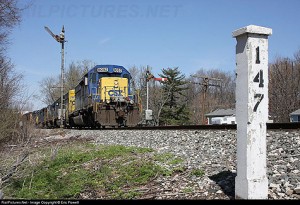


2011 is shaping up to be a busy year for the Paducah & Louisville RR thanks to Cane Run Coal facility in Louisville and a new NS train. Cane Run is up to three loaded trains a week. The empties return to Armstrong Coal, at McHenry, KY, Ohio County, for reloading.
The NS unit coal train (70J and 71J) loads at Alliance Coal at Princeton, Indiana, proceeds east across the NS (former Southern Ry) to Louisville, and interchanges with P&L in Louisville. Then it travels P&L to Jessup, KY (Kentucky Lake) to be unloaded. This sequence runs about two times a week and has NS power. The Mill Creek trains are still a daily operation.
The freight business is steadily rebounding and management wants to start running LP3 (Louisville-Paducah, southbound) and PL4 (Paducah-Louisville, northbound) six nights a week – the way we used to do it. It’s my understanding the only thing stopping that right now is a crew and power shortage.
The cement plant at Kosmosdale and the daytime local that serves it should be in full swing sometime in March or April. – Submitted by Bill Grady, Louisville, KY
Those of you who know a little about using scanners to listen in on radio communications while railfanning know that the industry is changing with CSX is poised to lead the way.
However, this may come at a hefty price to railfans – the adoption of FCC emission designator 4K00F1E, otherwise known as NXDN digital format – something that is not available in any current scanners (not even the high end digital ones).
The NXDN realization hit home early in 2011 here in Lafayette as callsign KEX475, otherwise known as CSX’s license for Shops Yard, was modified to include the new NXDN digital format. This same format is utilized by Christian County for all of it’s public safety communications, and will soon be utilized by Hopkins County public safety. The format is proving very prevalent as a cost alternative to the more universal APCO-25 (like that used by Kentucky State Police and numerous other states).
So is this the end of railroad scanning? No, not yet. The switch is still a ways out, but there’s more than one way to skin the proverbial cat… There is a software application that allows listeners to decode the NXDN format – a similar type setup like myself and Steve Miller utilize to decode the ATCS signals used on CSX’s CTC system. – Chris Dees
 The Frankfort, Kentucky “State Journal” has a front page story today (1-13-2011) about a group proposing to put in 70 MPH passenger train service between Winchester, Kentucky and Louisville, Kentucky (105 miles) using R J Corman and CSX track by 2012 for a cost of $75 million. Cost is given as $35 million for two diesel trains and $40 million for track improvement. Cost of ticket would be $8 between Lexington and Frankfort (25 miles). $40 million to upgrade 105 miles of 35 MPH track to 70 MPH?? All this done by October 2012?? === I would guess you would have to spend at least $70 million just to up grade on grade crossings with flashing lights and gates to run trains at 70 MPH, not to say any thing about track and signal upgrades, or building the proposed eleven stations with parking lots (Winchester, Lexington, Midway, Frankfort, Bagdad, Shelbyville, Simpsonville, Anchorage and elsewhere), plus constructing a new track connection to Union Station in Louisville. Wait a minute I forgot the EPA study that would have to be done before any work could be undertaken. This alone will cost $10 million and take ten years. Any way I would not plan on being trackside any time soon to photograph passenger train service between Winchester and Louisville. — Forgot to add they see no objections from people living along the track concerning this proposal.
The Frankfort, Kentucky “State Journal” has a front page story today (1-13-2011) about a group proposing to put in 70 MPH passenger train service between Winchester, Kentucky and Louisville, Kentucky (105 miles) using R J Corman and CSX track by 2012 for a cost of $75 million. Cost is given as $35 million for two diesel trains and $40 million for track improvement. Cost of ticket would be $8 between Lexington and Frankfort (25 miles). $40 million to upgrade 105 miles of 35 MPH track to 70 MPH?? All this done by October 2012?? === I would guess you would have to spend at least $70 million just to up grade on grade crossings with flashing lights and gates to run trains at 70 MPH, not to say any thing about track and signal upgrades, or building the proposed eleven stations with parking lots (Winchester, Lexington, Midway, Frankfort, Bagdad, Shelbyville, Simpsonville, Anchorage and elsewhere), plus constructing a new track connection to Union Station in Louisville. Wait a minute I forgot the EPA study that would have to be done before any work could be undertaken. This alone will cost $10 million and take ten years. Any way I would not plan on being trackside any time soon to photograph passenger train service between Winchester and Louisville. — Forgot to add they see no objections from people living along the track concerning this proposal.
Chuck Hinrichs
The “Old Goat” (Dennis Carnal) walks along the CSX Morganfield Branch, just west of Manitou, KY, where a loaded Dotiki unit coal train derailed in December, 2010, grounding seven aluminum 100-ton hoppers. – Photographs by Bill Thomas
 In case the group is not aware, G&W applied with the STB last month to abandon all of the Western Kentucky Railway. Western Kentucky Railway, LLC (“Applicant” or “WKRL”) is seeking an exemption to abandon all of its remaining lines of railroad (the “Subject Lines”) which Applicant believes are as follows:
In case the group is not aware, G&W applied with the STB last month to abandon all of the Western Kentucky Railway. Western Kentucky Railway, LLC (“Applicant” or “WKRL”) is seeking an exemption to abandon all of its remaining lines of railroad (the “Subject Lines”) which Applicant believes are as follows:
Submitted by Phil Randall
Hello Everyone.
I hope those in attendance of the January meeting found it to be enjoyable and informative. I apologize for my divided attention. Having an inexperienced man tending to the airport was playing heavily on my mind at the time. As it were, he handled the situation well and all was taken care of.
As a result of my inattentiveness, I allowed a motion to pass with out a vote. That being the dollar figure placed before the Chapter in regards to sending “our” rail camper to Scranton PA. I will bring this up as old business in February.
Two members have come to me, each with an idea, that I think will bring substance and growth to our Chapter. My response too both was to bring it up before the members and if need be, entertain a motion. Keep in mind; many ideas do not need a vote. For example, our Hopkinsville members host our meeting every year in May. This is almost taken for granted as we always “ask” them to confirm same. The same goes for the fall picnic in Crofton. If you have an idea for a function or event that does not require Chapter funds then take up the idea and sponsor same. If the Chapter chooses to embrace the idea, then we may need to vote on the level of participation as a Chapter.
Two things I plan to bring before the Chapter in February are: The Chapter Archives and Chapter participation in The City of Madisonville’s Friday Night Live events. These two items I feel are important to the Chapter as a whole. The archive needs our attention right away. The Friday Night Live events would be a way to get our name out there with out cost to the Chapter. It will however require participation from the membership. We will discuss both the Archive and Friday Night Live during the business meeting February 28th.
Wally will have the program and refreshment sign up sheet at the February meeting. If you are not on the list, please give thought to signing up for one or the other if not both. I can think of several regular members whom have not given a program in recent years. We need diversity and involvement from the membership. Please, step up and give support to our/YOUR Chapter.
So everyone try to make the meeting, join in the fun, bring a friend and we will promote our love of trains and everything railroading.
Rick Bivins

Keith Kittinger and grandson Trevor, enjoy a day out at the sHOw Train Show in Bowling Green, KY, Saturday, February 19. Several other chapter members were spotted at the annual event held at the Historic Rail Park.
CSX freight derailment – Rail fan trip to Metairie LA. Who would of known our trip would have ended this way. What are the chances of catching something like this on video.
First, let me say Thank You. Thank You for your vote of confidence. As I stated at the October 2010 meeting, after being nominated, “Remember, I can be out spoken sometimes”! I often am and I will be. But please understand that my outspoken nature comes from a desire to move forward or to improve something. I do not think that I speak out against something but rather speak out in favor of something. Perhaps too harshly at times. If I speak out and someone does not agree or like it…TELL ME!
Second. I title this as Rick’s Reply’s because; I searched the definition of President: One who presides, sits in leadership… How can one lead or preside over something that has zero input. How can I lead a group of rail enthusiast if I do not listen to them or have some idea of their likes, dislikes and objectives? The way I see it, I can not “lead” if I do not “reply” to You, NRHS Members!
Rich Hane led our group for, I believe Five Years. His easy going, kind nature gave our Chapter a “gentlemanly” feel. Even when disrupted, he held his composure, dealing with our objections as he did our combined positive ness. As the gentleman he is.
Rich followed Bob McCracken whom led us in much the same manor for many years.
I am afraid the Chapter will find me to be a bit different. I would like to see our Chapter set and achieve a few goals, to retain the “gentlemanly” nature, but with a forward moving posture. I will put ideas and goals “on the table” so to speak, but the membership will ultimately decide our Chapter’s direction.
One of my customers at the Airport told me that our U. S. President can not make or change law in this Country. He is the face of a nation, he “SETS THE TONE” of this country. That is true as research shows. This customer is a native of The Netherlands, a legal U.S. Citizen.
As Chapter President, I hope to set a tone, a positive tone. I hope we can combine our knowledge and energy’s to accomplish something, to move forward. Whether one is laying floor tile for the first time or making a photo archive available to several people, positive movement is needed. Even if we make a mistake, moving is always much better than standing still and looking at something.
I look forward to seeing you and hearing from you as we attend the first meeting of 2011 on January 24th at The L&N RR Station, Down town Madisonville at 7:00PM.
Again, Thank You.
Rick Bivins
 Remember the phrase “I love the smell of napalm in the morning” from one of those old war movies? Well fellow Hoosier Railfan, spent the morning of December 14, 2010, in Crawfordsville, watching CSX crews take down the remaining semaphores on the Monon Subdivision. Here’s his story from the North Central Indiana Railfan Yahoo Group.
Remember the phrase “I love the smell of napalm in the morning” from one of those old war movies? Well fellow Hoosier Railfan, spent the morning of December 14, 2010, in Crawfordsville, watching CSX crews take down the remaining semaphores on the Monon Subdivision. Here’s his story from the North Central Indiana Railfan Yahoo Group.
Northbound J726 was the last train to physically pass through the “blades” although they were all out of service by the time he came through late morning; the last train to actually use the authority granted by the semaphores would have been the northbound Hoosier State, which went through Crawfordsville in darkness and miraculously got to Lafayette only four minutes late.
The salvage crew started at Ames and took the blade and southbound color light signal down, then moved north. They weren’t too kind to the northbound semaphore at Main Street; it came down blade first, which wadded up the blade and shattered the red lens. After that, the boom operator was told to be a bit more gentle, which he most definitely was with the southbound signal.
Once the crews had the signals on the ground, the crews cut the mast just below the blade and motor and loaded it onto a truck; for a brief second, as the boom operator was lifting the blade/motor/finial/cut mast up onto the truck it was eerily similar to all the grisly severed heads in “Apocalypse Now.” Not pleasant.
After watching the “Nightmare at Main Street” I had enough and headed east toward Indianapolis, back to work and the “modern world”. The salvage trucks were on their way to the north side of town as I left. But my last memory of “shorty,” the short semaphore up at the north end of Crawfordsville, will forever be of J726 easing through with a friendly honk and wave from the hogger. I’m glad I decided to keep it that way.
Long Live The Monon, Eric Powell
We express our sympathy to Dennis and his family over the passing of his mother, Edith Carnal, December 15, 2010, at Brighton Cornerstone Healthcare in Madisonville. A memorial service was Sunday, December 19, 2pm, at First Christian Church, East Main Street, Earlington, KY. The family requests memorial gifts be made to the general fund of Earlington First Christian Church, PO Box 216, Earlington, KY 42410.
If you know of members who are or have been recently hospitalized, please forward the information to me, bill@fbcmadisonville.com
